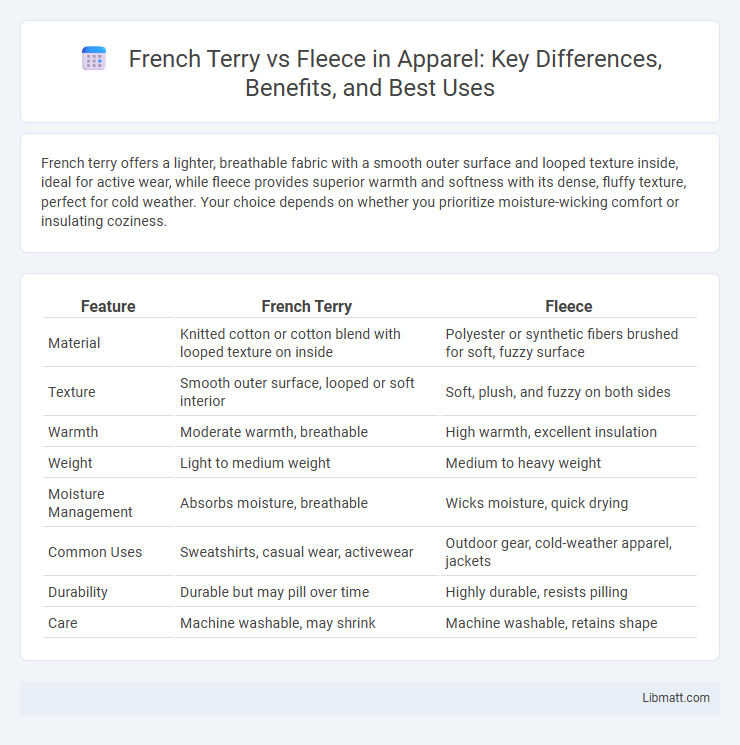French terry offers a lighter, breathable fabric with a smooth outer surface and looped texture inside, ideal for active wear, while fleece provides superior warmth and softness with its dense, fluffy texture, perfect for cold weather. Your choice depends on whether you prioritize moisture-wicking comfort or insulating coziness.
Table of Comparison
| Feature | French Terry | Fleece |
|---|---|---|
| Material | Knitted cotton or cotton blend with looped texture on inside | Polyester or synthetic fibers brushed for soft, fuzzy surface |
| Texture | Smooth outer surface, looped or soft interior | Soft, plush, and fuzzy on both sides |
| Warmth | Moderate warmth, breathable | High warmth, excellent insulation |
| Weight | Light to medium weight | Medium to heavy weight |
| Moisture Management | Absorbs moisture, breathable | Wicks moisture, quick drying |
| Common Uses | Sweatshirts, casual wear, activewear | Outdoor gear, cold-weather apparel, jackets |
| Durability | Durable but may pill over time | Highly durable, resists pilling |
| Care | Machine washable, may shrink | Machine washable, retains shape |
French Terry vs Fleece: Key Differences
French Terry features a looped texture on the inside and a smooth surface outside, offering lightweight breathability and moisture-wicking properties, ideal for activewear. Fleece has a soft, plush pile on both sides, providing superior warmth and insulation, making it suited for colder conditions and cozy garments. Your choice between French Terry vs Fleece should depend on desired warmth, fabric weight, and comfort level for specific uses.
Understanding Fabric Composition
French terry features a tight-knit cotton or cotton-blend fabric with uncut loops on the inside, offering moisture-wicking properties and breathability ideal for activewear. Fleece is typically made from synthetic fibers like polyester, providing a plush, insulating texture that retains heat and offers superior warmth for cold weather. Understanding the distinct fiber content and knit structures helps determine the best use of each fabric based on comfort, durability, and temperature regulation.
Texture and Feel Comparison
French terry features a smooth, flat surface with soft loops on the inside, offering a breathable yet cozy feel ideal for moderate temperatures. Fleece has a plush, fuzzy texture that provides superior warmth and insulation, making it perfect for colder weather. Your choice depends on whether you prioritize lightweight comfort or extra warmth in your fabric.
Warmth and Insulation Properties
French terry provides moderate warmth with its looped back design that offers breathability and moisture-wicking, making it ideal for mild to cool weather. Fleece excels in insulation due to its synthetic fibers and dense pile structure, trapping heat effectively for colder conditions. Your choice between French terry and fleece should hinge on the level of warmth required for your activities and climate.
Breathability and Comfort Levels
French terry offers superior breathability due to its looped texture on the inside and smooth surface on the outside, allowing better air circulation and moisture-wicking properties. Fleece, with its dense, plush fibers, provides exceptional warmth but tends to trap heat and reduce airflow, making it less breathable in comparison. Comfort levels in French terry are generally lighter and more suitable for moderate temperatures, while fleece excels in cold conditions due to its insulating qualities.
Durability and Longevity
French terry fabric offers superior durability due to its looped back design, which resists pilling and maintains shape after multiple washes. Fleece, while soft and insulating, tends to wear out faster with frequent use, often showing signs of thinning and pilling over time. Investing in French terry ensures longer-lasting apparel suitable for both casual wear and active lifestyles.
Care and Maintenance Tips
French terry requires gentle washing in cold water to preserve its soft loops and prevent shrinkage, while fleece is best cared for with mild detergents and low heat drying to maintain its plush texture and prevent pilling. Avoid using fabric softeners on both fabrics to retain their moisture-wicking and insulating properties. To keep Your garments in optimal condition, always follow the specific care instructions on the label and turn them inside out before washing.
Best Uses for French Terry
French terry fabric, characterized by its looped back and smooth front, excels in activewear and casual clothing due to its breathability and moisture-wicking properties. Ideal for lightweight sweatshirts, joggers, and loungewear, French terry offers comfort and flexibility without excessive warmth, making it perfect for transitional seasons. It outperforms fleece in versatility, providing a balance between warmth and ventilation for moderate climates and indoor wear.
Ideal Applications for Fleece
Fleece fabric is ideal for outdoor activities and cold-weather clothing due to its excellent insulation and moisture-wicking properties. Its lightweight yet warm nature makes it perfect for jackets, hoodies, and activewear designed to keep you comfortable during exercise or casual wear. Choosing fleece ensures durability and quick drying, making it suitable for layering in various climates.
Which Fabric Should You Choose?
French terry offers a lightweight, breathable texture ideal for mild weather and activewear, while fleece provides superior warmth and insulation suited for colder conditions. Choose French terry for moisture-wicking properties and a soft, smooth exterior perfect for layering, whereas fleece excels in plush comfort and heat retention during outdoor or winter activities. Selecting the right fabric depends on your climate, intended use, and preference for weight versus warmth.
French terry vs fleece Infographic

 libmatt.com
libmatt.com